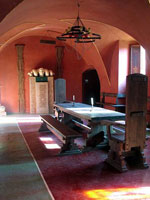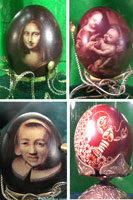Lately students are more and more willing to travel abroad: there they gain professional knowledge, learn history and culture of other countries. It is very good. However, it is sometimes sad when young people are more aware of the events that happened in Western Europe, but have little knowledge about what is interesting about the Ukrainian land. Today’s story is about the Sent-Moklosh castle, sited in Chinadievo, near Mukachevo. It is interesting that this was the first castle in Ukraine which was given by the state to a private person. The way to its current status was long – and very interesting.
The castle was first mentioned in 1450: baron Imre Pereni then got a permission to build a fortress near the rout Hust – Uzhhorod for the protection of travellers. The unfinished building was purchased by prince Mihai Telegdi (for 22 thousand forints): he built a palace and lived there; his family is buried in the dungeons of the St. Nicholas church. In the XVII century the fate of Sent-Miklosh was connected with the Rákóczi princes: in the 1600s it was the property of Transilvania governor Francis I Rákóczi, then the palace was owned by his wife Ilona Zrini, and further by their son Francis II Rákóczi, national hero of Hungary. In 1729 the mansion is passed to the owners of the Mukachevo dominion, Shenborns, who owned it for over two centuries. Of course, the years have left their trails on the castle walls. In 1943 Hungarian State commission of art has examined the fortress and began its restoration, in postwar years the building was used for different purposes and became even more ruined up until 2001, when the state leased it to a local painter Joseph Bartosh. He became the building’s good guardian angel. Nowadays, the castle has become a place of piligrimage for Ukrainian and foreign tourists; it hosts cultural events, art open airs and exhibitions, classical music concerts. A museum has been opened in the restored rooms of the first floor.
 The castle of love – this is what the Carpathian artist decided to turn this little known palace into, since in 1682 it was a place of birth of the greatest love of its time, which changed the fate of not only the two loving hearts, but of the whole nation. The whole Western Europe watched the events in the castle with bated breath.
The castle of love – this is what the Carpathian artist decided to turn this little known palace into, since in 1682 it was a place of birth of the greatest love of its time, which changed the fate of not only the two loving hearts, but of the whole nation. The whole Western Europe watched the events in the castle with bated breath.
Ilona Zrini, and she was the main character of the events, was a highly educated brave woman: she spoke Hungarian, Horwat, Czech, Slovak, Serbian, Polish, German, French, Old Greek and Latin. She was good at mathematics, jurisprudence, fortification and ballistics. She married prince Francis I Rákóczi and gave birth to 3 children. The Rákóczi family was princely with quite royal ambitions, at that time they withstood the Hubsburgs and looked for associates in Turkey.
 Ilona Zrini and Francis Rákóczi, possibly, were a happy couple, but Ilona’s mother-in-law was terrible. Her name was Sophia Batori and she hated her daughter-in-law almost from the first sight. However, ironically, it was Ilona who, as a widow, after Sophia’s death inherited the Palanok Mukachevo castle, Sophia’s citadel. Ilona was then almost 40 but she remained a glorious beauty and soon remarried Earl Imre Tekeli who was 14 years younger. It was Sent-Miklosh castle where they secretly met.
Ilona Zrini and Francis Rákóczi, possibly, were a happy couple, but Ilona’s mother-in-law was terrible. Her name was Sophia Batori and she hated her daughter-in-law almost from the first sight. However, ironically, it was Ilona who, as a widow, after Sophia’s death inherited the Palanok Mukachevo castle, Sophia’s citadel. Ilona was then almost 40 but she remained a glorious beauty and soon remarried Earl Imre Tekeli who was 14 years younger. It was Sent-Miklosh castle where they secretly met.
In politics beautiful Ilona was disciple of her first husband: she was enemies with Hubsburgs and looked for support in the Porte, where Earl Tekeli – then the head of rebels – went with a diplomatic mission. However, the talks fell through and her beloved was imprisoned. The Hubsburgs immediately sent a twenty thousand army under the command of General Eneas Caprari in order to pacificismy the insubordinate princess and dispossess the Mukachevo castle. Ilona could counteract this force with only 2 thousand guardsmen and several hundreds of villagers. With this handful of defenders she restrained the siege for 3 years! She personally gave orders, planned sallies, checked posts and patrols, took care of the wounded and prepared food. However, it didn’t go without bribery and treason. It is said that over unrequited love for the owner of the castle the Office head Antonin Obslon either forged a letter from her husband or poisoned the water in the well, - in a word, Ilona was forced to lay down arms. The conquerors deprived her from her wealth, forbade her to see her children and later sent her from Austria-Hungary. She spent the last years of her life with her husband in Turkey.
 In fact, it was a sacrifice, Ilona Zrini sacrificed everything for her love. And for her people. Now the people of Hungary tenderly preserve remembrance of this unusual woman. Sent-Miklosh castle is considered the fortress of solidarity, where visitors swear allegiance to each other, men ask their beloved to marry them, more and more young couples hold their weddings here, while in the Middle Ages it was customary to marry at a place of worship, which allegedly became the key to a happy married life. However, no couple will be the first to get married at Sent-Miklosh. Joseph himself did this with Tetjana Petrychko, talented woman, famous artist who paints Easter eggs. Tetjana Bartosh is the only Easter eggs master who received the manufacturer’s certificate for scrapped Easter eggs – having boiled chicken eggs in onion pelt for several hours, she scrapes drawings on them with the help of a curved shaving blade and a needle. It takes her from a week to a month to make one piece. The collection, exhibited in the castle, consists of 10 pieces. The rest was either sold or given to somebody as a gift. Most famous pieces are copies of paintings by Leonardo da Vinci "Monna Lisa", Rembrandts "Portrait of an old woman". It seems that Tetjana is the muse not only for Joseph, but for Sent-Miklosh as well – it was thanks to her that they met and the artist found the place he had been looking for his whole life, and the palace found its new owner, with whom came its new era.
In fact, it was a sacrifice, Ilona Zrini sacrificed everything for her love. And for her people. Now the people of Hungary tenderly preserve remembrance of this unusual woman. Sent-Miklosh castle is considered the fortress of solidarity, where visitors swear allegiance to each other, men ask their beloved to marry them, more and more young couples hold their weddings here, while in the Middle Ages it was customary to marry at a place of worship, which allegedly became the key to a happy married life. However, no couple will be the first to get married at Sent-Miklosh. Joseph himself did this with Tetjana Petrychko, talented woman, famous artist who paints Easter eggs. Tetjana Bartosh is the only Easter eggs master who received the manufacturer’s certificate for scrapped Easter eggs – having boiled chicken eggs in onion pelt for several hours, she scrapes drawings on them with the help of a curved shaving blade and a needle. It takes her from a week to a month to make one piece. The collection, exhibited in the castle, consists of 10 pieces. The rest was either sold or given to somebody as a gift. Most famous pieces are copies of paintings by Leonardo da Vinci "Monna Lisa", Rembrandts "Portrait of an old woman". It seems that Tetjana is the muse not only for Joseph, but for Sent-Miklosh as well – it was thanks to her that they met and the artist found the place he had been looking for his whole life, and the palace found its new owner, with whom came its new era.

